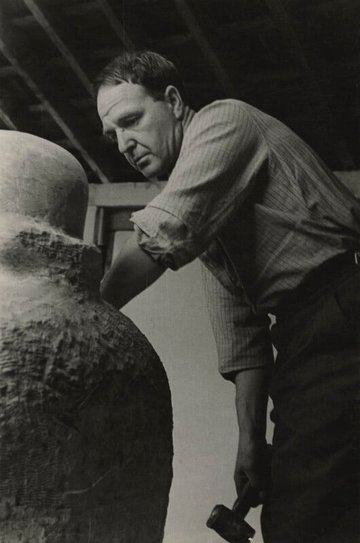
Henry Moore
‐
English artist best known for his sculptures
Other names
Henry Spencer Moore
Place of birth
About
Born in the mining town of Castleford in West Yorkshire, Henry Moore gained an international reputation during his lifetime for his prolific work as a sculptor. He began his formal training in Leeds and was the first sculpture student at the Leeds School of Art. He was introduced to a wide range of art whilst still in Yorkshire, first through his schoolteacher Alice Gostick and then via his acquaintance with Sir Michael Sadler, the Vice-Chancellor of Leeds University, who was a collector of modern art.
His studies were interrupted by the First World War when he was called up to fight at the age of 18, serving in the Civil Service Rifles, 11th London Regiment. After the war, he moved to London to study and teach at the Royal College of Art, having been awarded a scholarship. Moore’s artistic imagination was fired by frequent trips to the collections of the British Museum, the Victoria and Albert Museum and Zwemmer’s bookshop. A travelling scholarship also enabled him to visit Italy and France in 1924, where he visited numerous museums. He was particularly captivated by an Indian sculpture he saw at the Musée Guimet in Paris and wrote in an excited letter that it was one of the finest pieces of sculpture he had ever seen. The sculpture from India, Africa and Oceania that Moore encountered through his trips to museums and in the books he collected undoubtedly shaped his oeuvre, which was based predominantly on the human body. Moore also credited Roger Fry’s book Vision and Design, which examined art from beyond Europe, with having a profound impact on him. In the 1920s and 1930s, Moore’s reputation was confirmed with solo exhibitions and public commissions.
In the 1930s he was involved with an international group of artists based in London – many of them émigrés of the Second World War – who promoted the idea of abstract art as a universal language. Other artists who he was close to at this time include Barbara Hepworth, Ben Nicholson, Naum Gabo, Paul Nash and his lifelong supporter, the poet, writer and critic Herbert Read. Moore’s reputation as an international figure was cemented in the 1940s with the publication of his Shelter Drawings depicting London’s populace seeking protection underground from the Blitz. Moore was friends with the poet and editor M. J. Tambimuttu, whose Poetry London Editions published Moore’s Shelter Sketch-Book in 1945. He also contributed a lively and colourful front cover depicting two lyre birds for the magazine Poetry London (no. 8, 1942).
After the war Moore’s work was exhibited all over the world and he was enthusiastically promoted by the British Council in particular. He also executed prestigious commissions, such as the 1958 Reclining Figure outside the UNESCO headquarters in Paris, and his work and name have become associated with post-war internationalism. Perry Green in Hertfordshire, which had been home to Moore’s family and his workshops and studios since 1940, houses the Henry Moore Foundation today.
Herbert Read, Sir Michael Sadler, M. J. Tambimuttu.
Shelter Sketch-Book (London: Editions Poetry London, 1945)
Davis, Alexander (ed.) Henry Moore: Bibliography, 5 vols (Much Hadham: Henry Moore Foundation, 1992–5)
BBC Written Archives Centre, Caversham Park, Reading (written transcripts of BBC interviews)
British Museum (Shelter Sketch-Book)
Letters and photographs, Dartington Hall Archives, Devon
The Henry Moore Foundation, Perry Green, Much Hadham, Hertfordshire
The Henry Moore Institute Archive, Leeds
British Council Papers, National Archives, Kew, UK
Letters and correspondence, Tate Gallery Archives, London
University of Leeds Special Collections
Image credit
Henry Moore by Howard Coster, bromide print, 1944, NPG x2038
© National Portrait Gallery, London, Creative Commons, http://creativecommons.org/licenses/by-nc-nd/3.0/
